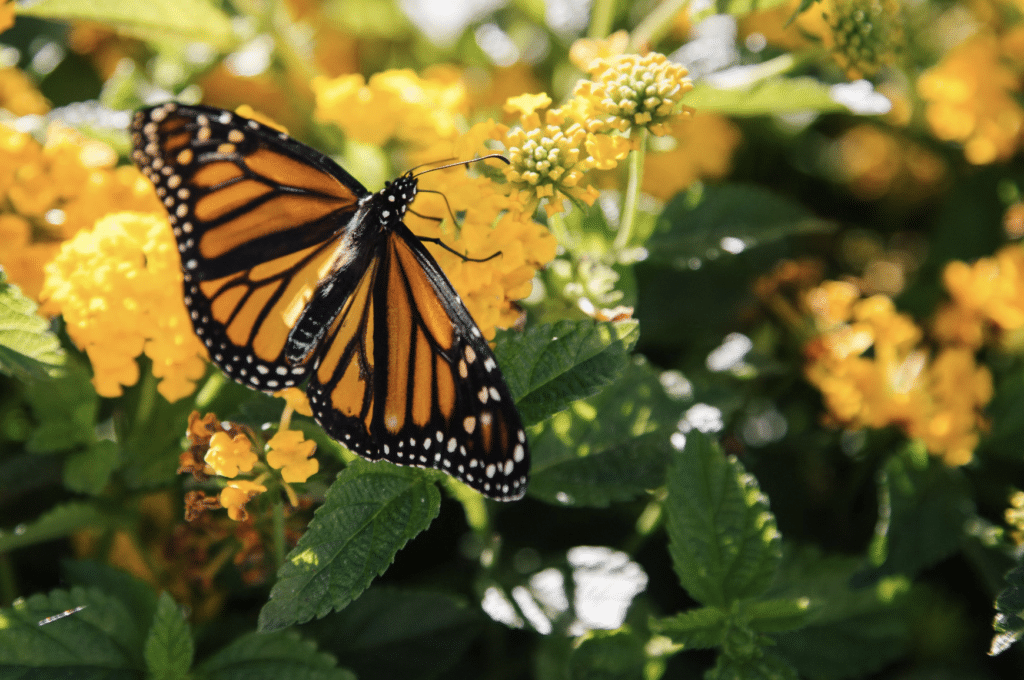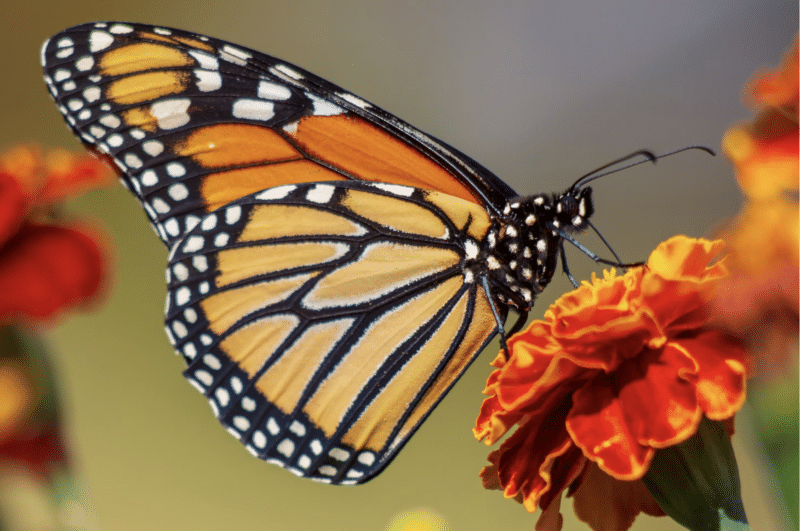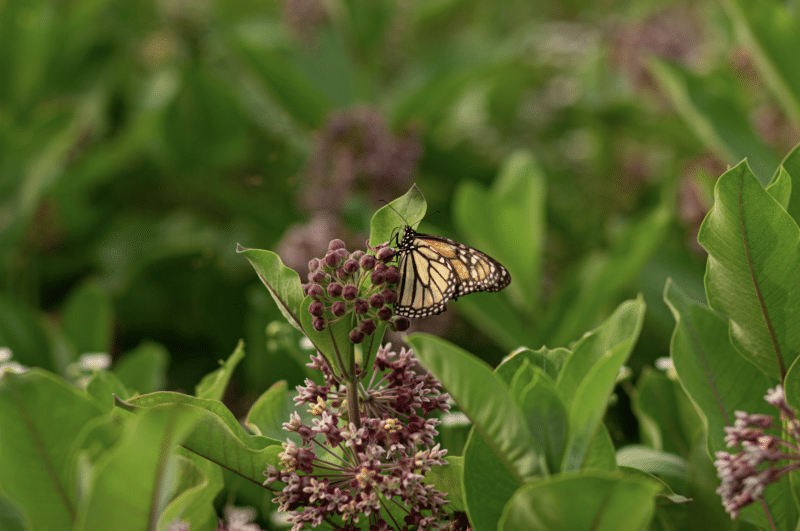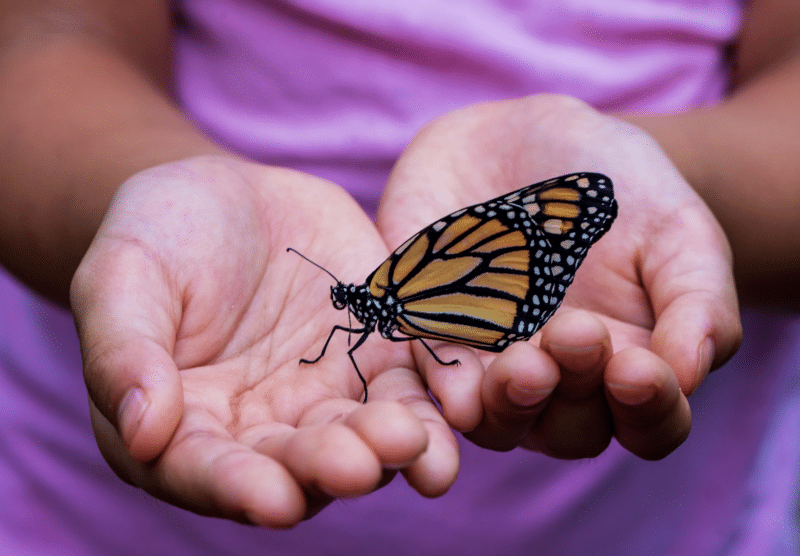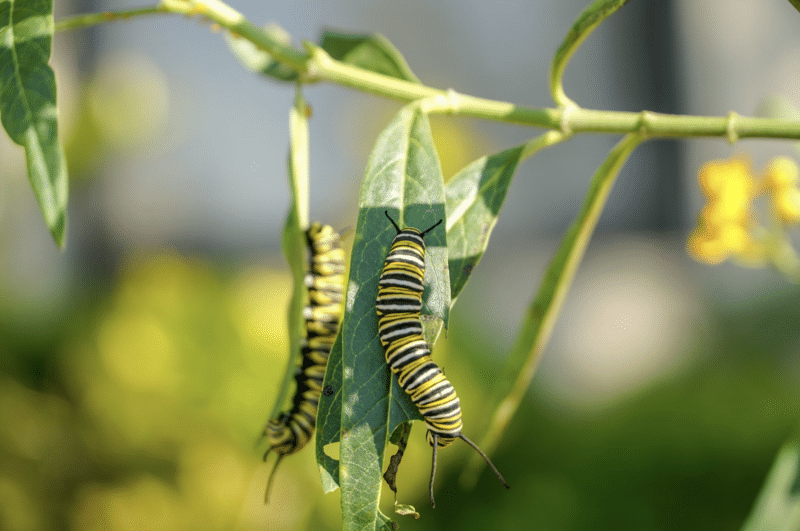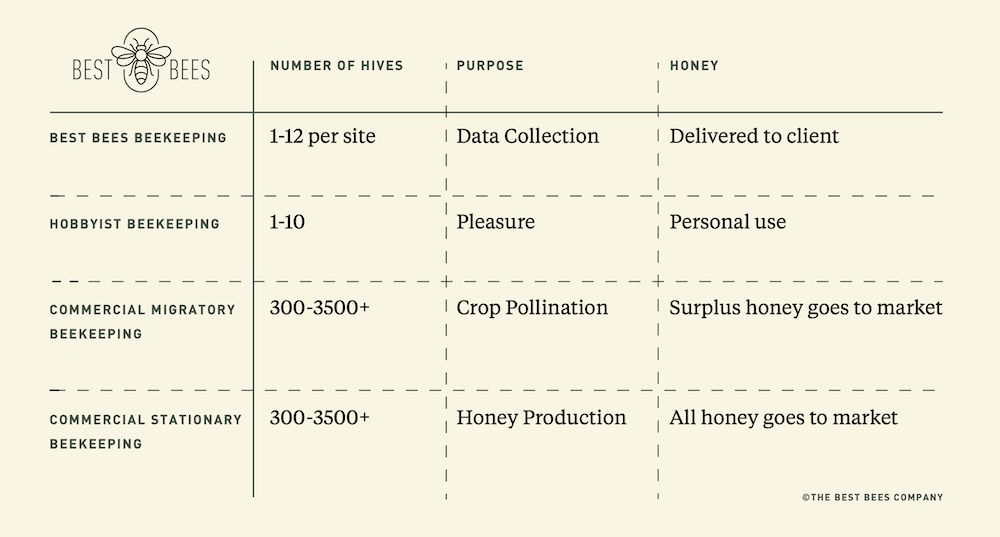Contents:
- The Famous Monarch Butterfly
- Monarch Butterfly Physical Characteristics
- The Monarch Butterfly: Beautiful, Popular, and Vulnerable to Extinction
- Why Milkweed is so Important to Monarch Butterflies
- The Monarch Butterfly Life Cycle
- Monarch Butterfly Migration and Overwintering
- Why are Monarchs Important?
- Monarch Butterfly Conservation Efforts
- What Can You Do to Help Monarchs?
- FAQs
The Famous Monarch Butterfly
While we know they’re essential participants in a healthy ecosystem, by and large, people don’t seem to be very fond of insects. Many of us fear being stung by wasps, are grossed-out by centipedes, pull caterpillars off garden plants, swat flies, zap mosquitos, and call exterminators whenever we find termites in our houses. There is one group of insects, though, that we all seem to love: butterflies. Among the more than 700 different butterfly species in North America, there’s one that everyone knows well: the monarch.
The migratory monarch butterfly, Danaus plexippus subspecies plexippus, is indigenous to Northern Mexico, the U.S. and Southern Canada. Their popularity comes from both their easily identifiable color and markings (orange with black veins, and black and white spotted wing tips), and their migratory behavior — while most butterflies live relatively solitary lives in one small area, monarchs migrate for thousands of miles, and roost together in trees each night during their journey.
Monarch Butterfly Physical Characteristics
During their larval phase, monarch caterpillars have black, white and yellow stripes and are about two inches long. After metamorphosis, they emerge as adult butterflies with wing spans of three to four inches. Adult monarchs weigh about half a gram – slightly less than a single raisin!
They have two sets of orange wings with black veins and borders, with a double row of white spots within the black borders. Their orange coloration is a signal to predators that they, like most all yellow and orange insects, are toxic. Male and female butterflies are almost identical, but males are typically larger than the females and have slightly narrower veins on their wings.
The Monarch Butterfly: Beautiful, Popular, and Vulnerable to Extinction
In the 19th century, settlers in the Midwest reported clouds of migrating monarchs so large and dense, they darkened the skies. Monarchs today are in severe decline. There are two populations of monarchs: eastern and western. While genetically the same, their population size and migratory patterns are quite different.
Eastern monarchs are located east of the Rocky Mountains, and migrate up to 3,000 miles from as far north as southern Canada to Central Mexico. Western monarchs are located west of the Rockies, and migrate from the Canadian border to southern California.
The population of eastern monarchs is much larger than western monarchs. According to the Center for Biological Diversity, eastern monarch populations have lost up to 85% of their numbers since the 1990’s, and western monarch populations have fallen by 99% in the same time period. According to the US Fish and Wildlife Service, there is a more than 50% chance that eastern monarch butterflies could be extinct within 60 years, and a 99% chance that western monarchs will face the same fate, if essential actions are not taken to save them, too.
While the dire straits facing monarch butterflies might seem obvious given their precipitous decline, national and international organizations monitoring them have not always agreed on their status.
In their September 2020 Monarch Butterfly Species Status Assessment Report, The US Fish and Wildlife Service concluded that they faced possible extinction by 2080 under current conditions, and an even stronger likelihood of extinction under projected environmental changes. While the Service announced in December of 2020 that the species qualified for protection under the US Endangered Species Act, they declined to list monarchs, stating that “…adding the monarch butterfly to the list of threatened and endangered species is warranted but precluded by work on higher-priority listing actions.”
The International Union for Conservation of Nature (IUCN) announced in July 2022 that they were placing the monarch butterfly on their Red List of Threatened Species as Endangered, threatened by habitat destruction and climate change.
However, just 14 months later, they downgraded monarchs’ status to vulnerable to extinction. The reason, according to National Geographic, was that “…models showing the insect’s demise were likely too cautious, and its numbers are falling more slowly than thought, according to the IUCN.”
The NatGeo article included studies done by Andy Davis, an animal ecologist at the University of Georgia. His findings showed that monarch populations have not universally declined, and that in some areas, populations have remained stable or have actually grown.
While a slowing of their decline may seem like positive news, a number of factors, such as habitat loss, climate change, and the use of pesticides and herbicides, indicate that monarchs are still vulnerable to extinction.
Habitat Loss and Degradation
According to the World Wildlife Federation, forest degradation in core areas in Mexico where monarchs overwinter tripled in 2021-23, with more than 18.8 hectares lost due to fire, sanitary cutting, illegal logging and fires. Summer breeding habitat in the Midwest has been dramatically reduced through intensive farming practices and suburban sprawl — an estimated 167 million acres where Monarchs lay their eggs and their caterpillars feed have been lost in the past 30 years alone.
Climate Change
The study “Changes in climate drive recent monarch butterfly dynamics” by Erin Zylstra et al, published in Nature, Ecology and Evolution journal, revealed that breeding season weather changes were more than seven times more likely to explain changes in summer populations of monarch butterflies.
These findings are unsurprising considering monarch butterfly mating and migration is cued, in part, by temperature changes. With longer, warmer summers, the insects remain in the north longer, but when temperatures drop quickly, many monarchs are killed.
Once they are in Mexico, they may begin migrating too early or too late depending on the weather and climate patterns they experience. An unseasonably cold winter may kill many of the hibernating monarchs; an unseasonably warm winter may cause them to leave too early, running into deadly cold as they travel north.
– Forest Wildlife, “How Is The Monarch Butterfly Affected By Climate Change“
Pesticides and Herbicides Usage
The widespread use of agricultural pesticides kills untold numbers of monarch caterpillars and butterflies each year. In the Midwest, agricultural use of herbicides is believed to have eliminated most of the milkweed population – the only plant where monarchs will lay their eggs.
A study cited by the Royal Entomological Society in 2016 estimates that the loss of almost 900 million milkweed plants due to the use of agricultural herbicides in the midwest could mean a monarch capacity loss of 71%.
Why Milkweed is so Important to Monarch Butterflies
Monarch butterflies need milkweed plants in order to successfully raise subsequent generations of monarchs. The adult butterflies will only lay their eggs on the underside of milkweed leaves. Once they hatch, monarch caterpillars feed exclusively on those leaves. There are over 100 species of milkweed genus Asclepius found in North America; among these about 25 are food sources for larval monarchs.
Milkweed actually has toxic compounds called cardenolides within its leaves. Monarchs have a peculiarity in a crucial protein in their bodies, a sodium pump, that the cardenolide toxins usually interfere with. Through a series of mutations (something biologists call a “constrained adaptive walk”), the structure of this pump evolved to make it harder for the cardenolides to bind to it. This evolutionary innovation allows the monarch to minimize the competition they face from other animals for food sources. It also allows the butterflies to repel predators. Far from harming the monarch larvae, ingesting these compounds make both the larval and butterfly stages of monarchs toxic to potential predators.
While monarchs lay their eggs on milkweed, one of the chief pollinators of milkweed is the bumble bee. The bumble bee is one of the few pollinators capable of accessing the plant’s nectar and pollen. The decline in bumble bee populations exacerbates an already dangerous situation for monarchs: fewer bumble bees mean fewer milkweed plants pollinated, which means fewer new milkweed plants for the remaining monarchs to lay eggs on.
Adult monarchs are much less choosy than their caterpillars — they feed on nectar found in many different flowering plants, and so should be less vulnerable, but habitat loss through intensive agriculture and suburban development is reducing nectar supplies for adult monarchs, threatening their survival as well.
The Monarch Butterfly Life Cycle
Similar to the honey bee life cycle, the monarch butterfly life cycle spans four phases:
- egg
- larva
- chrysalis
- adult
Each of these phases is relatively brief — an egg takes three to five days to hatch, a larvae/caterpillar lives for 11-18 days before it forms a chrysalis, and metamorphosis from larva to caterpillar takes 8-14 days within a chrysalis. Once they emerge from the chrysalis in a process called eclosion, adult monarch butterflies live for 22-37 days, depending on ambient temperature. The total lifespan of a monarch, from egg to adult, is just 6-10 weeks.
A monarch butterfly chrysalis is a green, spindle-shaped pupa that hangs from the underside of a milkweed plant leaf. They are about three to four inches long and are made largely of the skin of the larva. The green color helps to camouflage the helpless pupa during its two-week stay within the chrysalis. As the metamorphosis from larva to adult nears completion, the chrysalis becomes transparent, showing the soon to emerge adult in all its beautiful colors.
Monarch butterflies typically live for just two to six weeks. In their migration north from Mexico, they go through several of these short-lived generations. In their fourth and final generation, monarchs born in September and October live much longer. This is known as the “Methuselah generation” which lives much longer, following one long migratory path back to their winter habitat.
Monarchs in the Methuselah generation are similar to “diutinus bees,” or “winter bees,” which live longer than their summer counterparts. Once spring arrives, these Methuselah generation monarchs sexually mature, reproduce, and lay the eggs that will become the next generation that will migrate north, starting the cycle all over again.
Monarch Butterfly Migration and Overwintering

Western monarch butterflies overwinter in Northwestern Mexico, the northern Baja, and the southernmost parts of California. Eastern monarchs overwinter in a mountainous area of Central Mexico. During their migrations north, western monarchs move into the Sierra, Cascade, and Coastal Ranges, as well as the western side of the Great Basin. Eastern monarchs have a much wider range, eventually reaching the plains of Alberta and Saskatchewan, and the Canadian Maritime Provinces, stopping at every U.S. state east of the Mississippi. As neither the northern nor southern migrating generations have ever been to their destination, scientists believe that monarchs are genetically programmed to follow established flyways and navigate by the magnetic pull of the earth and the position of the sun.
During their migration, monarchs commonly roost in pine, fir, and cedar trees every evening. They choose these trees because their dense canopies provide warmth and protection from predators. Clustering together helps to conserve body heat during the cool hours of darkness. In the morning they bask on the top of branches to warm their bodies before taking flight.
While the northern migration can take three to four generations and last more than six months, the return migration is completed by only one generation in a period of about two months. It’s amazing to think that these seemingly fragile animals are capable of flying as much as 3,000 miles in such a short period!
How they’re able to accomplish this incredible journey is something scientists have only just surmised. It seems that the white spots on the monarchs’ wings absorb less sun than the black around them, and that frequent alternation of cool and heat on their wings creates a series of micro-vortices that reduce wind drag, making monarchs highly efficient fliers.
When they reach their overwintering grounds, they roost in Oyamel fir forest in Northern Mexico, and eucalyptus, Monterey pine and Monterey cypresses in California. In Mexico, monarchs can cluster in the tens of thousands on a single tree.
Why are Monarchs Important?
To maintain a healthy ecosystem, we need plant diversity, and 80% of the world’s flowering plants depend on pollination for reproduction. Monarch butterflies are an important pollinator of many flowering plants, especially native wildflowers. While toxic to many animal species, monarchs in both their caterpillar and butterfly life stages are a valuable food source for some birds and predatory insects.
Outside the food chain, monarchs play an important role in engaging people in the natural world and supporting efforts to restore the environment. They’re the frequent star of many classroom science projects and help get children from an early age interested in science and the environment. As beloved creatures, they remind many of the beauty of nature. Awareness of their plight is helping engage many in the fight to stop climate change, preserve habitat and reverse ecological damage.
Monarch Butterfly Conservation Efforts
In recognition of the importance of monarch butterflies, the Mexican government created the Monarch Butterfly Biosphere Reserve to protect the Oyamel fir forests where the majority of monarchs overwinter in the states of Mexico and Michoacan.
This 62-square mile forest preserve was expanded in 2000 to include 217 square miles of critical habitat. While foresting is prohibited there, poor farmers supplement their income through illegal logging. US and Mexican nonprofits are working together to help local residents find alternative sources of income and sustainable ways to plant and manage new forests.
In recognition of the environment shared by Canada, Mexico, and the US, and the need monarchs have for habitat in which to breed and feed in each country, the three nations have created a North American Monarch Conservation Plan to help conserve the species.
A partnership of federal & state agencies, NGO’s, businesses, and academic groups has created The Monarch Joint Venture (MJV) to promote understanding of the plight of monarchs and to encourage individuals and groups to work together to protect the species. MJV laid out a Conservation Plan in 2021 that includes four pillars:
- Habitat Conservation
- Education & Outreach
- Research & Monitoring
- Partnerships
The USDA Forest Service has developed a strategic framework for protecting monarch butterflies. This framework guides the use of forestry resources and helps the Forestry Service engage in partnerships with public and private agencies to further the cause of monarch preservation.
Democratic members of the U.S. House of Representatives submitted a bill this past June (H.R.4350: Monarch Act of 2023) designed “to encourage and facilitate efforts by States and other stakeholders to conserve and sustain the western population of monarch butterflies…”.
A number of non-profit organizations are working to restore habitat, promote planting of milkweed, and encourage the reduction/elimination of pesticides and herbicides in industrial agriculture, facility management, and home gardening. These include the National Wildlife Federation, Save Our Monarchs, and Monarch Watch.
What Can You Do to Help the Monarch Butterfly?
While the decline in monarch populations may seem dismal, it’s not too late to save them. It doesn’t take much to protect just one monarch, and when your actions are repeated by thousands of concerned people across North America, we can turn things around. You can help to accelerate the process by promoting the need for action and encouraging your local, state and federal representatives to take action.
Here are 7 simple things you can do today:
- Stop using pesticides and herbicides on your property. If you live in an apartment or condo, ask your property managers to do the same. This will help to save other endangered pollinators, too, such as native bees, honey bees and butterflies.
- If you have a garden or window box, plant some milkweed — it’s easy to grow, and will provide essential habitat for monarch larvae.
- Purchase FSC certified wood products to help prevent illegal logging of critical monarch overwintering and migratory habits.
- Do as much as you can to fight climate change by conserving energy, recycling waste, using more efficient means of transportation, and consuming more sustainably grown food.
- Tell friends, family, neighbors and co-workers about the plight of monarch butterflies and how they can join you in saving them.
- Write to your elected officials and ask them to support monarch conservation efforts, such as H.R. 4350: Monarch Act of 2023.
- Make a contribution to non-profits working to save monarchs, such as National Wildlife Federation, Save Our Monarchs, and Monarch Watch.
FAQs
Q: Are monarch butterflies endangered?
A: All evidence suggests that they are endangered, and many conservationists believe that they face dangerous odds of extinction within 50-60 years. Unfortunately, while there is clear evidence of their severe decline, especially on the West Coast, they’re not yet listed as an endangered species by the US Fish & Wildlife Service. The International Union for the Conservation of Nature (IUCN), the leading global authority on the status of biological diversity, has declared that Monarch butterflies are vulnerable to extinction.
Q: How many monarch butterflies are left?
A: Estimates of overwintering populations in Mexico suggest that there may be between 40 and 50 million eastern monarchs left. While that might seem like a lot, their population just 30 years ago was closer to 400 million. According to the National Wildlife Federation, the 26th Annual Western Monarch Thanksgiving Count in California, found 335,479 in November 2023.
Q: Is there anything that can be done about this, or are they doomed to extinction?
A: Yes, there is action to be taken!. Government and non-profit organizations are working to protect overwintering habitat in Mexico and migratory habitat in the US. Concerned citizens can do a lot to help locally, including avoiding pesticide and herbicide use, planting milkweed in their gardens, taking personal action to help slow climate change, promoting solutions to friends, and advocating for more government action.
Q: How long do monarch butterflies live?
A: Monarch butterflies have four stages in their life cycle. Each of these phases can last from 2 to 37 days. A typical monarch butterfly will live from two to six weeks.
Q: What do monarch butterflies eat?
A: In their larval stage, monarch caterpillars eat only one type of plant: milkweed. Milkweed provides the caterpillars with essential nourishment. Additionally, the ingestion of toxins present in milkweed helps to protect both larvae and adults from predators, who see their yellow and orange coloring as a sign that they are inedible.
Q: Why do monarch butterflies cluster on trees?
A: Monarchs cluster on trees while migrating to conserve heat at night and to protect themselves from predators. They choose evergreen trees, such as firs, pines, and cedars, because their dense canopies retain heat and moisture and help to camouflage the butterflies.


